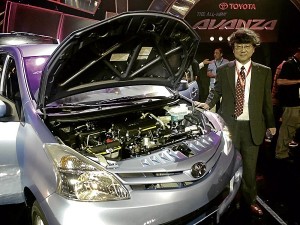
HOSOKAWA, the man behind the worldwide success of Toyota’s IMV, or Innovative International Multi-Purpose Vehicle, design, stands proud beside one of his best creations. EUGENE ARANETA
Kaoru Hosokawa, Toyota’s executive chief engineer, carries that certain “look” that is easily identifiable, and hard to forget. Some admirers call it “the genius look,” while others would go even further and call it the “mad scientist” look.
The look, however which way you put it, is justified. This good-natured engineer has been responsible for the worldwide success of Toyota’s IMV, or Innovative International Multi-Purpose Vehicle design. For that feat, Toyota executives have conferred on him the ultimate compliment by just simply calling him “legend.” Hosokawa-san, who holds the position of general manager of Japan and Europe’s product planning division, was present at the recent launch of the 2012 Avanza at the Bonifacio Global City Tent, and naturally, Inquirer Motoring wasted no time picking the brains of the genius, mad scientist, or legend—whichever moniker makes the hair on your head stand on end.
IM: What’s your reaction when the big bosses at Toyota call you the “legend”?
KH: I am very glad to be called a legendary chief engineer. I think it is an overestimation. I think they evaluated the success of IMV project over the past many years around the globe.
IM: How did you become an engineer, and how did you end up with Toyota?
KH: In the days when I was a student, I had the hope that I would design (something) that would remain in the hearts of customers. It (turned out that it) would be a car. I studied engineering at Osaka University in Japan. To realize the dream, I joined TMC in 1979.
IM: Let’s talk about your creation, the Avanza. In terms of dimensions, how does the new Avanza compare with the previous one?
KH: The latest model is 20 mm longer and 15 mm wider. Our intention is that by using such extra dimension, we created a wider interior.
IM: Does this difference have an effect on stability? We test-drove the old Avanza, and felt the height adversely affecting ride stability.
KH: When you compare the vehicle height with passenger cars, Avanza is higher. Higher vehicles are influenced more by side winds. It becomes unstable. So, to reduce such instability, this time we modified the suspension, making the new Avanza stand firmly on the ground. It was a very important job for the engineer of the chassis department. The new Avanza gives drivers stability even during strong side wind conditions, rough roads, floods, and so on.
IM: How about the handling, in general?
KH: The new Avanza has smooth handling. Not only is the ride smooth, the steering is reliable. You can feel by hand through the steering wheel the movement of the vehicle. You feel as if you’re firmly on the ground. The steering system of the new Avanza gives the driver the precise feel that he can drive the vehicle with safety in mind in every kind of road.
IM: How about changes or improvements in the engine?
KH: We did adjustments of the combustion, optimizing the balance between the driving performance like acceleration and fuel efficiency. There are many, many ways to improve. We carried over the same gear ratios for the transmission and the rear differential. It means that the previous was the best for Asian countries.
IM: Why did you adjust the combustion?
KH: Every driver expects better acceleration and fuel economy, not only for the Asian region but also worldwide. Especially for some countries like Indonesia and the Philippines with many mountains. We elaborated on the right gear ratio to climb steep slopes easily.
IM: So you claim that the new Avanza has shown an eight-percent improvement in fuel efficiency.
KH: An eight-percent improvement was what we could do at most.
IM: How would you assess the cost of owning this new Avanza compared to the previous one?
KH: I think there would be no drastic change in ownership cost. It means that for the previous model, from the viewpoint of the cost of ownership, customers of Avanza were satisfied. It is always economical owning an Avanza.
IM: How were you able to come out with a more lightweight Avanza despite adding length and width?
KH: Yes, the new Avanza is approximately 10 kg lighter than the previous model. We put in so many improvements on the new model. But instead of increasing weight, this time we made it lighter.
In the engineering world, we have learned many technology improvements in the past several years and we put them in the new Avanza design as much as possible. Examples of material change include using more plastic, thinner but stronger and safer metal plates, making the shape of the parts smaller, or simpler or integrated, and so on.